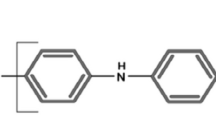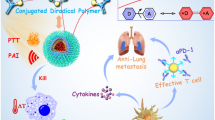Abstract
Photodynamic therapy (PDT) by near-infrared (NIR) irradiation is a promising technique for treating various cancers. Here, we reported the development of free-standing wafer-scale Au nanosheets (NSs) that exhibited an impressive PDT effect. The Au NSs were synthesized by ionic layer epitaxy at the air-water interface with a uniform thickness in the range from 2 to 8.5 nm. These Au NSs were found very effective in generating singlet oxygen under NIR irradiation. In vitro cellular study showed that the Au NSs had very low cytotoxicity and high PDT efficiency due to their uniform 2D morphology. Au NSs could kill cancer cells after 5 min NIR irradiation with little heat generation. This performance is comparable to using 10 times mass loading of Au nanoparticles (NPs). This work suggests that two-dimensional (2D) Au NSs could be a new type of biocompatible nanomaterial for PDT of cancer with an extraordinary photon conversion and cancer cell killing efficiency.

Similar content being viewed by others
References
Dolmans, D. E. J. G. J.; Fukumura, D.; Jain, R. K. Photodynamic therapy for cancer. Nat. Rev. Cancer 2003, 3, 380–387.
Castano, A. P.; Mroz, P.; Hamblin, M. R. Photodynamic therapy and anti-tumour immunity. Nat. Rev. Cancer 2006, 6, 535–545.
Cosgarea, R.; Susan, M.; Crisan, M.; Senila, S. Photodynamic therapy using topical 5-aminolaevulinic acid vs. surgery for basal cell carcinoma. J. Eur. Acad. Dermatol. Venereol. 2013, 27, 980–984.
Lee, P. K.; Kloser, A. Current methods for photodynamic therapy in the US: Comparison of MAL/PDT and ALA/PDT. J. Drugs Dermatol. 2013, 12, 925–930.
Rhodes, L. E.; de Rie, M. A.; Leifsdottir, R.; Yu, R. C.; Bachmann, I.; Goulden, V.; Wong, G. A.; Richard, M. A.; Anstey, A.; Wolf, P. Five-year follow-up of a randomized, prospective trial of topical methyl aminolevulinate photodynamic therapy vs surgery for nodular basal cell carcinoma. Arch. Dermatol. 2007, 143, 1131–1136.
Weissleder, R. A clearer vision for in vivo imaging. Nat. Biotechnol. 2001, 19, 316.317.
Connor, E. E.; Mwamuka, J.; Gole, A.; Murphy, C. J.; Wyatt, M. D. Gold nanoparticles are taken up by human cells but do not cause acute cytotoxicity. Small 2005, 1, 325–327.
Cheng, Y.; Samia, A. C.; Meyers, J. D.; Panagopoulos, I.; Fei, B. W.; Burda, C. Highly efficient drug delivery with gold nanoparticle vectors for in vivo photodynamic therapy of cancer. J. Am. Chem. Soc. 2008, 130, 10643–10647.
Hone, D. C.; Walker, P. I.; Evans-Gowing, R.; FitzGerald, S.; Beeby, A.; Chambrier, I.; Cook, M. J.; Russell, D. A. Generation of cytotoxic singlet oxygen via phthalocyanine-stabilized gold nanoparticles: A potential delivery vehicle for photodynamic therapy. Langmuir 2002, 18, 2985–2987.
Burda, C.; Chen, X. B.; Narayanan, R.; El-Sayed, M. A. Chemistry and properties of nanocrystals of different shapes. Chem. Rev. 2005, 105, 1025–1102.
Chen, H. J.; Ming, T.; Zhao, L.; Wang, F.; Sun, L. D.; Wang, J. F.; Yan, C. H. Plasmon-molecule interactions. Nano Today 2010, 5, 494–505.
Sapsford, K. E.; Berti, L.; Medintz, I. L. Materials for fluorescence resonance energy transfer analysis: Beyond traditional donor-acceptor combinations. Angew. Chem., Int. Ed. 2006, 45, 4562–4589.
Haiss, W.; Thanh, N. T. K.; Aveyard, J.; Fernig, D. G. Determination of size and concentration of gold nanoparticles from UV.Vis spectra. Anal. Chem. 2007, 79, 4215–4221.
Foss, Jr., C. A.; Hornyak, G. L.; Stockert, J. A.; Martin, C. R. Template-synthesized nanoscopic gold particles: Optical spectra and the effects of particle size and shape. J. Phys. Chem. 1994, 98, 2963–2971.
Vankayala, R.; Kuo, C. L.; Sagadevan, A.; Chen, P. H.; Chiang, C. S.; Hwang, K. C. Morphology dependent photosensitization and formation of singlet oxygen (1Δg) by gold and silver nanoparticles and its application in cancer treatment. J. Mater. Chem. B 2013, 1, 4379–4387.
Wang, F.; Seo, J. H.; Luo, G. F.; Starr, M. B.; Li, Z. D.; Geng, D. L.; Yin, X.; Wang, S. Y.; Fraser, D. G.; Morgan, D. et al. Nanometrethick single-crystalline nanosheets grown at the water-air interface. Nat. Commun. 2016, 7, 10444.
Yin, X.; Chen, Q. Y.; Tian, P.; Zhang, P.; Zhang, Z. Y.; Voyles, P. M.; Wang, X. D. Ionic layer epitaxy of nanometer-thick palladium nanosheets with enhanced electrocatalytic properties. Chem. Mater. 2018, 30, 3308–3314.
Redmond, R. W.; Gamlin, J. N. A compilation of singlet oxygen yields from biologically relevant molecules. Photochem. Photobiolgy 1999, 70, 391–475.
Yin, X.; Shi, Y. Q.; Wei, Y. B.; Joo, Y.; Gopalan, P.; Szlufarska, I.; Wang, X. D. Unit cell level thickness control of single-crystalline zinc oxide nanosheets enabled by electrical double-layer confinement. Langmuir 2017, 33, 7708–7714.
Jacquemain, D.; Wolf, S. G.; Leveiller, F.; Deutsch, M.; Kjaer, K.; Als-Nielsen, J.; Lahav, M.; Leiserowitz, L. Two-dimensional crystallography of amphiphilic molecules at the air-water interface. Angew. Chem., Int. Ed. 1992, 31, 130–152.
Jacquemain, D.; Leveiller, F.; Weinbach, S. P.; Lahav, M.; Leiserowitz, L.; Kjaer, K.; Als-Nielsen, J. Crystal structure of self-aggregates of insoluble aliphatic amphiphilic molecules at the air-water interface. An X-ray synchrotron study. J. Am. Chem. Soc. 1991, 113, 7684–7691.
He, Y. Q.; Liu, S. P.; Kong, L.; Liu, Z. F. A study on the sizes and concentrations of gold nanoparticles by spectra of absorption, resonance Rayleigh scattering and resonance non-linear scattering. Spectrochim. Acta Part A: Mol. Biomol. Spectrosc. 2005, 61, 2861–2866.
Chen, Y.; Gu, X.; Nie, C. G.; Jiang, Z. Y.; Xie, Z. X.; Lin, C. J. Shape controlled growth of gold nanoparticles by a solution synthesis. Chem. Commun. 2005, 4181–4183.
Wang, S. G.; Lu, W. T.; Tovmachenko, O.; Rai, U. S.; Yu, H. T.; Ray, P. C. Challenge in understanding size and shape dependent toxicity of gold nanomaterials in human skin keratinocytes. Chem. Phys. Lett. 2008, 463, 145–149.
Choi, K.; Riviere, J. E.; Monteiro-Riviere, N. A. Protein corona modulation of hepatocyte uptake and molecular mechanisms of gold nanoparticle toxicity. Nanotoxicology 2017, 11, 64–75.
Flors, C.; Fryer, M. J.; Waring, J.; Reeder, B.; Bechtold, U.; Mullineaux, P. M.; Nonell, S.; Wilson, M. T.; Baker, N. R. Imaging the production of singlet oxygen in vivo using a new fluorescent sensor, Singlet Oxygen Sensor Green®. J. Exp. Bot. 2006, 57, 1725–1734.
Gollmer, A.; Arnbjerg, J.; Blaikie, F. H.; Pedersen, B. W.; Breitenbach, T.; Daasbjerg, K.; Glasius, M.; Ogilby, P. R. Singlet Oxygen Sensor Green®: Photochemical behavior in solution and in a mammalian cell. Photochem. Photobiol. 2011, 87, 671–679.
Ragas, X.; Jimenez-Banzo, A.; Sanchez-Garcia, D.; Batllori, X.; Nonell, S. Singlet oxygen photosensitisation by the fluorescent probe Singlet Oxygen Sensor Green®. Chem. Commun. 2009, 2920–2922.
Satoh, A. Y.; Trosko, J. E.; Masten, S. J. Methylene blue dye test for rapid qualitative detection of hydroxyl radicals formed in a fenton's reaction aqueous solution. Environ. Sci. Technol. 2007, 41, 2881–2887.
Zhang, C.; Zhao, K. L.; Bu, W. B.; Ni, D. L.; Liu, Y. Y.; Feng, J. W.; Shi, J. L. Marriage of scintillator and semiconductor for synchronous radiotherapy and deep photodynamic therapy with diminished oxygen dependence. Angew. Chem., Int. Ed. 2015, 54, 1770–1774.
Kuo, W. S.; Chang, Y. T.; Cho, K. C.; Chiu, K. C.; Lien, C. H.; Yeh, C. S.; Chen, S. J. Gold nanomaterials conjugated with indocyanine green for dual-modality photodynamic and photothermal therapy. Biomaterials 2012, 33, 3270–3278.
Vankayala, R.; Huang, Y. K.; Kalluru, P.; Chiang, C. S.; Hwang, K. C. First demonstration of gold nanorods-mediated photodynamic therapeutic destruction of tumors via near infra-red light activation. Small 2014, 10, 1612–1622.
Zhao, T. T.; Shen, X. Q.; Li, L.; Guan, Z. P.; Gao, N. Y.; Yuan, P. Y.; Yao, S. Q.; Xu, Q. H.; Xu, G. Q. Gold nanorods as dual photo-sensitizing and imaging agents for two-photon photodynamic therapy. Nanoscale 2012, 4, 7712–7719.
Vankayala, R.; Lin, C. C.; Kalluru, P.; Chiang, C. S.; Hwang, K. C. Gold nanoshells-mediated bimodal photodynamic and photothermal cancer treatment using ultra-low doses of near infrared light. Biomaterials 2014, 35, 5527–5538.
Vijayaraghavan, P.; Liu, C. H.; Vankayala, R.; Chiang, C. S.; Hwang, K. C. Designing multi-branched gold nanoechinus for NIR light activated dual modal photodynamic and photothermal therapy in the second biological window. Adv. Mater. 2014, 26, 6689–6695.
Lin, J.; Wang, S. J.; Huang, P.; Wang, Z.; Chen, S. H.; Niu, G.; Li, W. W.; He, J.; Cui, D. X.; Lu, G. M. et al. Photosensitizer-loaded gold vesicles with strong plasmonic coupling effect for imaging-guided photothermal/photodynamic therapy. ACS Nano 2013, 7, 5320–5329.
Kim, Y. K.; Na, H. K.; Kim, S.; Jang, H. J.; Chang, S. J.; Min, D. H. One-pot synthesis of multifunctional Au@ graphene oxide nanocolloid core@ Shell nanoparticles for raman bioimaging, photothermal, and photodynamic therapy. Small 2015, 11, 2527–2535.
Acknowledgements
This work was supported by the Army Research Office (No. W911NF-16-1-0198), the National Science Foundation (No. DMR-1709025), and National Institutes of Health (Nos. R01EB0213360, 1R21EB027857, and P30CA014520). Diffraction data was collected at ChemMatCARS Sector 15, which is principally supported by the Divisions of Chemistry and Materials Research, National Science Foundation, under grant number NSF/CHE-1834750. Use of the Advanced Photon Source, an Office of Science User Facility operated for the U.S. Department of Energy (DOE) Office of Science by Argonne National Laboratory, was supported by the U.S. DOE (No. DEAC02-06CH11357).
Author information
Authors and Affiliations
Corresponding authors
Electronic supplementary material
Rights and permissions
About this article
Cite this article
Zhang, Z., Ni, D., Wang, F. et al. In vitro study of enhanced photodynamic cancer cell killing effect by nanometer-thick gold nanosheets. Nano Res. 13, 3217–3223 (2020). https://doi.org/10.1007/s12274-020-2990-7
Received:
Revised:
Accepted:
Published:
Issue Date:
DOI: https://doi.org/10.1007/s12274-020-2990-7




